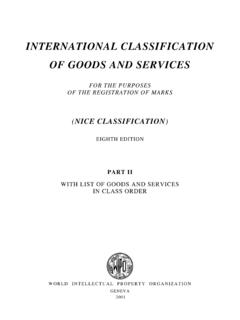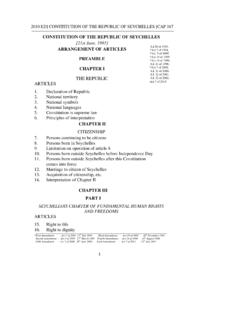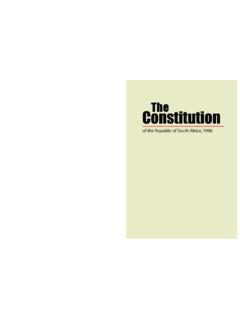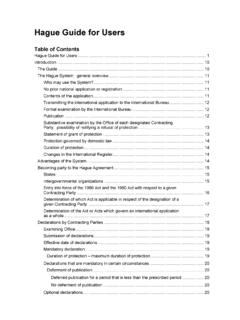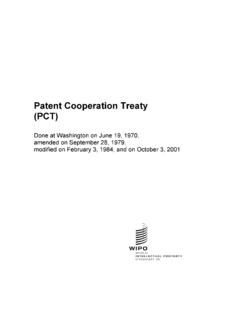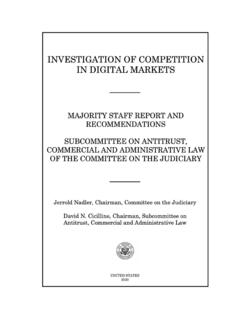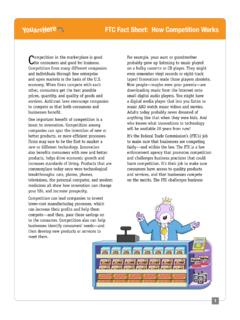Transcription of WORLD INTELLECTUAL PROPERTY ORGANIZATION …
1 1 WORLD INTELLECTUAL PROPERTY ORGANIZATION (WIPO) PATENT POOLS AND ANTITRUST A COMPARATIVE ANALYSIS Prepared by the Secretariat (March 2014) 2 Contents I. Introduction and Purpose .. 3 II. Patent Pools An Overview .. 3 Substitute Patents and Complementary Patents .. 4 Essential and Non-Essential Patents .. 5 Standardization and Patent Pools .. 6 Standard Setting and F/RAND Terms .. 8 Effects on competition .. 9 Pro-Competitive Effects .. 9 Competitive Concerns ..10 III. IP/Antitrust Guidelines in Selected United Canada ..13 Japan ..14 European Union ..15 IV. Conclusions ..17 3 I. Introduction and Purpose 1. Patent pools can be defined as an agreement between two or more patent owners to license one or more of their patents to one another or to third parties.
2 Often, patent pools are associated with complex technologies that require complementary patents in order to provide efficient technical solutions. Generally, these patent pools cover mature technologies. Pools also frequently represent the basis for industry standards that supply firms with the necessary technologies to develop compatible products and services. In that case, they rather concern technologies that are yet to be fully developed. 2. Patent pools have been the subject of ongoing discussions from both a legal and an economic perspective. On the one hand, patent pools may have positive effects on competition and innovation. By sharing INTELLECTUAL PROPERTY assets, companies may develop new products and reduce their transaction costs.
3 On the other hand, under specific circumstances, patent pools may provide an opportunity for a possible anti-competitive behavior: like any cooperation among competitors, they involve an inherent risk of collusive behavior. In other words, a patent pool may be regarded as a cartel. In addition, there may be competition -related concerns regarding the licensing practices and restrictions they entail. The so-called patent thickets ( , overlapping patent rights controlled by rights holders that require innovators to reach licensing deals for multiple patents from multiple sources1) can lead to increased transaction costs and to chilling effects on the development of new products.
4 3. Although there is a general consensus on the positive and efficiency-enhancing effects of patent pools, there may be instances where the creation of patent pools may lead to possible competition rules violations depending on the applicable antitrust rules: (i) The creation of patent pools may distort competition if pro-competitive aspects do not outweigh the (potential) limitations on competition ; (ii) The licensing clauses may limit the rights of the patent holders and therefore infringe applicable antitrust statutes; and (iii) The patent pool may lead to anti-competitive collusion among competitors. 4. The purpose of this report is to analyze benefits and risks of patent pools, including some economic considerations concerning their welfare-enhancing effects.
5 In addition, we will discuss relevant legal approaches and case law in several jurisdictions. II. Patent Pools An Overview 5. In a patent pool, patent rights are aggregated amongst multiple patent holders. Then, the pooled patents are made available to member and non-member licensees and typically the pool allocates a portion of the licensing fees it collects to each member in proportion to each patent's A patent pool may take the form of a joint venture3, created by two or more patent holders for the purpose of sharing their INTELLECTUAL PROPERTY rights. 1 Digital Opportunity, A review of INTELLECTUAL PROPERTY and Growth, An independent report by Ian Hargreaves, May 2011, page 18 2 Robert P.
6 Merges, Institutions for INTELLECTUAL PROPERTY Transactions: The Case of Patent Pools, in Expanding the Boundaries of INTELLECTUAL PROPERTY , Innovation Policy for the Knowledge Society, 123, 129 (Rochelle Cooper Dreyfuss et al. eds., 2001). 3 It is possible that the creation of a joint venture needs to be filed with the relevant competition authority as a merger agreement. However, this report does not cover concentration effects of mergers und antitrust rules. 4 6. Historically, patent pools have been concentrated in Europe and the United States although recently Asian companies increased their participation in patent pools given their growing role in technological 7. Whether patent pools may trigger antitrust scrutiny depends, among other factors, on the concerned technologies or patents.
7 As for the nature of the pooled technologies/patents, they can be categorized as (i) complementary or (ii) substitutes and, in a standard setting environment, as (iii) essential or (iv) non-essential. These categories are important for assessing the impact on competition and are analyzed below. Substitute Patents and Complementary Patents 8. Two patents are considered substitutes if they cover alternative technologies and are non-blocking5. The technologies covered by substitute patents can be used in parallel without infringing the other patent. They are therefore potentially competing with each other. 9. From a technological point of view, complementary patents must be used together to produce a specific output and are not substitutes for each other.
8 Thus, from a technical point of view it is necessary to use complementary patents together in the production process. Therefore, it is required to either be the owner or a licensee of the complementary patents to produce the desired output. 10. In addition, two mutually blocking patents are complementary from a legal point of view. Mutually blocking patents can be described as two patents that infringe on each other. Hence, patent licensing agreements are necessary to produce the desired output to avoid patent infringement claims. It is also possible that patents are one-way blocking, meaning that one patent infringes another patent while the latter doesn t necessarily infringe the first Mutually blocking patent rights are the result of cumulative innovation, where no technological component can be marketed individually without the technological complements protected by patent rights of different 11.
9 Differentiating between complementary and substitute (or competing) patents is important when assessing the effects of patent pools on competition . Substitute patents compete with each other and should therefore, from a competition point of view, not be bundled in a pool because, as a result, competition between such substitute technologies would be eliminated. In general, this concern does not apply to complementary patents because actual or potential competition is not lessened. In line with these considerations, antitrust recommendations in both the and Europe9 state that pooling complementary patents is generally 4 WORLD INTELLECTUAL PROPERTY Report 2011, The Changing Face of Innovation, Chapter 3: Balancing Collaboration and competition , 121, available at 5 A patent concerning a particular technological field is non-blocking when it does not prevent the use of another patent in the same field because it relies on a technology not covered by the first patent.
10 6 Charles River Associates Ltd., Report on Multiparty Licensing, 6, available at The legal solution for one-way blocking patents reciprocal or cross compulsory licensing can be found in Article 31(l) of the Agreement on Trade-Related Aspects of INTELLECTUAL PROPERTY (TRIPS), of 1994, where the invention covered by the second patent represents an important technical advance of considerable economic significance in relation to the invention claimed in the first patent. 7 Justus Baron & Henry Delcamp, Patent quality and value in discrete and cumulative innovation, Working Paper 2010-07, Cerna Working Paper Series, 3, available at (last visited on February 11th, 2013). 8 DOJ & FTC, Antitrust enforcement and INTELLECTUAL PROPERTY Rights: Promoting Innovation and competition , 9, available at (last visited on February 19th, 2013).

